PinotFile: 6.16 February 19, 2007
|
4th International Wine & Heart Health Summit
These are the sage words of Hermann Smith-Johannson, a cross-country skier who lived to the ripe age of 103 years. The American public has become obsessed with anti-aging research and claims (note the cover of the latest issue of Fortune) and yet part of the solution to a long and healthy life has been with us since antiquity. Physicians have been prescribing wine, as we know from records in ancient Canaan and Cairo, for at least 5000 years. The esteemed physician, Dr. William Osler, was noted to say in the 1800s, “Beverage alcohol is our most valuable medicinal agent and it is the milk of old age.” And it wasn’t only physicians that knew of the health benefits of wine. America’s most beloved spokesman, Wills Rogers, once said, “The wine had such ill effects on Noah’s health that it was all he could do to live 950 years. Just 19 years short of Methuselah. Show me a total abstainer that ever lived that long.” 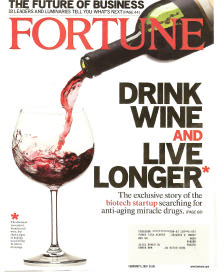 The United States is projected to lead the world in volume of wine consumed by year 2010. Appropriate education of the public (and physicians) about regular, moderate, and responsible drinking of wine could have a very large impact on the health of this country. It is estimated that 71 million Americans have cardiovascular disease (CVD), or 1 in 3, and CVD is the #1 killer. Cardiovascular disease touches each of us through our family and friends. A large amount of credible literature has accumulated in the last 25 years that supports that which educated observers have sensed for a long time, namely, that wine in moderation is good for heart health. 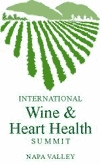 I recently attended the 4th International Wine and Heart Health Summit held in Napa Valley, California. This landmark conference, under the direction of The Desert Heart Foundation in affiliation with the Renaud Society and the University of New Mexico School of Medicine, presented to attending doctors, research scientists, food scientists, writers, and consumers the latest scientific literature on wine and health. The chairman and the person most responsible for spearheading this biannual event, is Tedd M. Goldfinger, DO, who heads the Desert Heart Foundation in Tucson, Arizona.  There is a plethora of research and epidemiologic studies available about alcoholic beverages and health in addition to the talks presented at this Summit. In this report, I am going to try to sift through all of this maize of scientific information, and attempt to simplify and summarize the knowledge in a user-friendly format. I realize that I am preaching to the choir, in that most readers are already wine enthusiasts who have some belief in the health effects of wine. But perhaps this critical review can provide further clarity and stimulate the dissemination of this valuable public health information. I have tried to control my personal biases and look at the data with a critical eye. In addition, I have attempted to present the facts in layman’s terms whenever possible. The inconsistencies and conflicting findings and the vagaries of human nature make definitive claims always difficult in medicine and can, excuse the pun, drive you to drink. Take this humorous piece by Malcolm Kushner (Vintage Humor for Wine Lovers) which sets the stage for the discussion to follow:
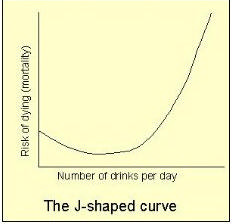 In the 1970s, Arthur Klatsky, M.D., first reported on the benefit of alcohol consumption in reducing mortality and preventing cardiovascular disease (CVD). He confirmed the J-shaped curve relationship between daily alcohol intake and total mortality first described by Raymond Pearl in 1926. The composite alcohol-total mortality relationship is a J-shaped curve with the lowest risk among drinkers who take less than 3 drinks per day. This curve has been validated by extensive epidemiological studies and holds true for CVD, some cancers, and cognitive dysfunction as well. Definitions vary, but light to moderate drinking is considered less than 3 drinks per day while heavy drinking is 3 or more drinks per day. The definition of a standard drink varies widely from country to country. In the United States, a standard drink contains 17.7 ml of ethanol (equivalent to 12 oz of beer, 5 oz of wine, and a shot of 80 proof distilled spirits). In the UK, a standard drink has 10 ml of ethanol. In the United States, a half bottle of wine contains about 2½ to 3½ drinks depending on the alcohol percentage. To determine the number of drinks in a half bottle, multiple 375 ml by the alcohol percentage and divide by 17.7. If you drink a half bottle of wine that is 13% alcohol, 375 ml x 0.13 = 48.75 divided by 17.7 = 2.7 drinks. A half bottle of 16% alcohol wine will contain ½ drink more. If we go back to the early 1990s, alcohol was under attack from many sources including MADD (Mothers Against Drunk Driving) and prohibitionist groups. The business climate for wine production was strained by many factors including high interest rates. The National Institutes of Health (NIH) refused to support any research on alcohol and health. The studies of Klatsky and others were largely pushed into the background. In 1974, the Framingham Heart Study showed that the risk factors for CVD were smoking, high blood pressure, increased cholesterol, and abstinence from alcohol. The NIH, which sponsored the study, was so concerned about the “evils” of drinking, they ordered the researchers to remove all reference to alcohol in their published report. They advised the researchers to either provide no comment or state that “It (alcohol) has no effect.” During this time period, Serge Renaud, PhD, working at the French National Institute for Health, and Curtis Ellison, MD, a professor at Boston University, proposed to the NIH a cross-cultural epidemiological study on the health effects of alcohol. The NIH rejected the application and these researchers fortunately had the fortitude to search elsewhere for their funding.
 Morley Safer, a reporter on the popular CBS television program, 60 Minutes, was a Francophile whose neighbor was the French-born chef, Jacque Pépin. Pépin had told Safer (right) that the French had a very low rate of CVD and Safer was curious. Safer consulted with Curtis Ellison, MD, professor and chief of preventive medicine and epidemiology at Boston University School of Medicine. Ellison told him the French secret came simply down to wine, food and lifestyle. The French were known to outlive Americans by about two and a half years and suffer 40% fewer heart attacks even though smoking was a national pastime, their diet was loaded with saturated fat, and exercise was, well, an afterthought. The French, however, consumed moderate amounts of red wine regularly with meals, they ate more fresh fruit and vegetables, they took longer to eat meals and snacked less, they ate less red meat and more cheese, and used more olive oil and less lard or butter. Of these factors, Ellison said the link with moderate and regular consumption of wine with meals was the strongest and most scientifically proven. Frenchman, Serge Renaud, PhD, had studied the relationship between the low rate of CVD and moderate wine intake in the French population and had confirmed Ellison’s beliefs. Safer aired the now famous program on the “French Paradox” on November 17, 1991. Safer asked Renaud on air what the lower mortality for CVD in the French was due to. Renaud answered, “I think it is the alcohol.” Safer closed the show holding up a glass of red wine and by the next day, red wine mania had hit the United States. Within weeks of this program, sales of red wine in the United States shot up 40% (about 2.5 million bottles), and Gallo Winery had to put their leading brand, Hearty Burgundy, on allocation. You might say that America had taken the health message to heart. This was a seminal event that restored optimism in the wine industry, set the tone for political correctness in describing alcohol as beneficial, and caught the imagination of the public. 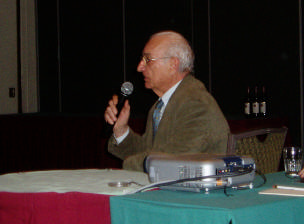 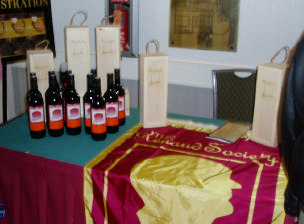 Serge Renaud published his now famous paper in the medical journal, The Lancet : “Wine, alcohol, platelets, and the French paradox for coronary heart disease.” (S. Renaud and M. De Lorgeril, June 20, 1992, pp 1523-1526). In this paper, he emphasized that “At the moderate intake of alcohol associated with the prevention of coronary heart disease (CHD), the mechanism of protection seems to be, at least partly, a hemostatic effect, possibly a decrease in platelet reactivity.” It became soon apparent to Renaud and others that the explanation of the French paradox was “due to at least partly to a moderate intake of wine, possibly through polyphenols.” Serge Renaud, now in his 70’s, is pictured above at the recent Summit. His legacy has been preserved with the formation of The Renaud Society, a group of medical professionals with an interest in better health and a passion for wine. At the meeting, the inaugural Renaud Society wine was introduced. It is a meritage Bordeaux Superieur from the 2003 vintage bottled by The Famille Manein in Bordeaux. Wine has been shown to have multiple biological effects. Below is a summary of the major categories. Digestive Wine is potent against Escheria coli and other bacteria. Interestingly, this has been known back to at least the time of the Roman Empire, when the armies carried wine with them in their travels to avoid diarrhea. Wine has been shown to reduce gall bladder disease. An unwelcome effect is that alcohol will increase gastric reflux and may be troublesome to those with hiatal hernia. Cardiovascular Effects are widespread and multiple including antioxidant effects by preventing oxidation of molecules such as LDL, (the low-density lipoprotein, so-called “bad cholesterol” which in its oxidized state contributes to atherosclerosis or plaque formation and hardening of arteries); direct effects such as increasing HDL (high-density lipoprotein, or “good” cholesterol which is anti-inflammatory and reduces the risk of atherosclerosis; anti-thrombotic or anti-coagulation effect (reduces the “stickiness” of platelets); and modification of the function of the vascular endothelium (in cell culture red wine inhibits endothelin or ET1 which causes blood vessel constriction leading to atherosclerosis). The actions of wine are very complex, and poorly understood at this time. The lay press has referred to the ability of polyphenols in wine to “mop up free radicals,” as an explanation for their cardiovascular benefit, but certainly this public explanation is an over-simplification. Recent research indicates that specific effects on inflammatory processes are more important than antioxidant effects. Moderate drinkers may show a mild increase in blood pressure which is thought to have no clinical importance. Those with hypertension should not be discouraged from drinking moderately as long as they are on treatment for their high blood pressure. Studies have shown that the low to moderate intake of wine significantly reduces not only CVD and CHD, but also cerebrovascular accidents or stroke (CVA), congestive heart failure (CHF), high blood pressure, and peripheral vascular disease. Metabolic There is a 30% reduction in risk of developing diabetes mellitus with moderate wine consumption. In addition, diabetics who imbibe regularly and moderately have a decreased risk of dying from cardiovascular disease. There is a decreased rate of osteoporosis and multiple sclerosis in wine drinkers. Cancer There is an increased incidence of esophageal and breast cancer with high consumption of alcohol (more than 8 drinks a day in an Italian study). Women are faced with a dilemma in that there is about a 10% increase in breast cancer but a 50% reduction in CVD with light to moderate wine intake. If middle aged and older women have adequate folate in their diet and are not on hormone replacement therapy, the incidence of breast cancer in low to moderate drinkers of wine is the same as abstainers. Wine seems to decrease the risk of colorectal cancer, dramatically reduce the risk of gastric cancer, and decrease the incidence of kidney cancer, prostate cancer, and lymphoma. The beneficial mechanisms are complex, but it would seem that polyphenols in wine inhibit cellular events associated with tumor initiation, promotion, and progression. One polyphenol, resveratrol, may have also have therapeutic value in cancers. In animal studies, it promotes the death of cancer cells by inhibiting a gene, NF kappa B, which is released by the body’s immune system to protect cells, including cancer cells, from chemical and radiation attack. Mental Performance Wine seems to preserve cognitive function in aging individuals. There is a significant decreased risk of Alzheimer’s disease and dementia in low to moderate wine drinkers. Wine buyers tend to purchase and eat healthier food compared to people that buy beer. Also, there is an increasing IQ with increased preference for wine over other alcoholic beverages. Weight Change There are lower rates of obesity among drinkers and decreased weight gain overall. Although a drink of wine provides approximately 100 calories, wine is metabolized differently from other caloric intake. The French, who have a very low rate of obesity, are a perfect example of this observed effect. The observed favorable consequences of regular and moderate wine intake are thought to be secondary to the combined effects of alcohol and multiple polyphenols. Acting together, they influence vascular, hemostatic, and inflammatory functions that combine to produce cardioprotection, reduction in carcinogenesis, improved cognitive function, and a number of favorable metabolic changes. Much of the research on wine and health has centered on the polyphenols. These are chemical substances known as phytoalexins or phytochemicals, compounds derived from plants that have biological activity in the human body. In wine they include the flavonoids (resveratrol, quercetin, catechin, anthocyanin and procyanidin), tannins, and sulfides. The polyphenols are not unique to wine, and occur in abundance in many foods such as raspberries, blueberries, pomegranates, peanuts, green tea, extra virgin olive oil, and other plants. There are more polyphenols in wine than in grape juice because the fermentation process extracts more of these phytochemicals. One glass of red wine has 200 mg of phenolic compounds compared to 40 mg for white wine. There has been some interest of late in wines from specific regions, which by virtue of their vineyard locations and respective winemaking techniques, have particularly high levels of polyphenols such as resveratrol. For example, resveratrol levels are increased in red wines from Argentina where the vineyards are at high altitude. Presumably, the elevated concentration of polyphenols in the grapes develop as a protective response to the intense ultraviolet light at the increased altitudes. These wines have been shown in animals to be potent inhibitors of ET1 and the press has been quick to anoint these wines as “healthier.” A crazy idea, of course, because everyone knows Domaine de la Romanee-Conti Le Tache is the healthiest wine (just kidding). The fact is, and this was emphasized at the meeting I attended, only small amounts of polyphenols are required to produce their beneficial health effects. There is absolutely no evidence to indicate that a special polyphenol-endowed wine is healthier in humans. Don’t fall for the press hype. The crux of the matter is that light to moderate drinking of red wine is beneficial, regardless of the red wine that is imbibed. Resveratrol is the polyphenol “most likely to succeed” if you were to believe the press. There were at least 600 scientific studies in the literature in 2006 that mentioned resveratrol. Resveratrol has been shown to increase the life span of yeast cells, round worms, fruit flies, and short-lived fish. Research reported last November caused quite a stir in the press. A research team reported that mice fed high doses of resveratrol could be kept from gaining weight, despite being kept on a high fat diet. In addition, their aging process was slowed and their running stamina was improved. David Sinclair has been involved in a number of resveratrol studies and has partnered with CEO Christophe Westphal to form Sirtrus Pharmaceuticals to develop medications that have the same effect as resveratrol does on mice. In the Fortune article pictured on page 1 of this report, it is reported that the co-founders have raised $82 million over the past 2 years to fund their research. They have already developed a resveratrollike drug (501) that helps people with diabetes mellitus keep their blood sugar controlled. The drug delivers a large amount of resveratrol to the blood stream, in theory activating SIRT1 (the origin of the name Sirtrus for the company) which is an enzyme in cells that stimulates the formation of new, healthier mitochondria that do not throw off damaging radicals like their aging brethren. The result is a boost in the metabolic rate. At this point in time, it is not clear whether their research will be successful, as many scientists believe resveratrol has complex actions on many different molecules, and may need alcohol and other polyphenols to exert its full effects. The author of the article in Fortune, David Stipp, advises readers to “Pour a glass of Pinot Noir, and while imbibing, step back and regard the big picture. The dream (of extending life span) is likely to be realized within, at most, a few decades.” 25 facts to hang your stem on: 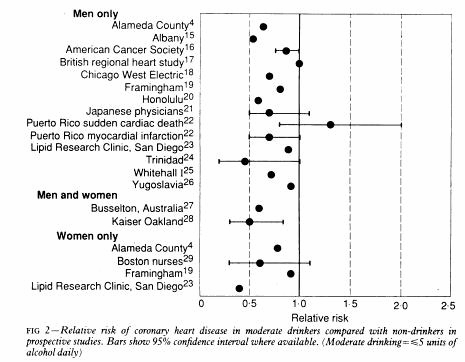 1. The mortality rate from CHD is lowest in Japan, second lowest in France. 2. Moderate drinkers of any type of alcohol have less CHD compared to abstainers (see graph). 3. The benefits of alcohol consumption last approximately 24 hours, so alcohol should be consumed regularly, even daily. 4. Binge drinking (3 drinks in less than 2 hours) negates the effects. The most benefit is gained from small amounts of alcohol drunk regularly. 5. Moderate drinking has little effect on cardiovascular medications (coumadin, blood pressure, hypoglycemic medications), in contradiction to warnings to the contrary. 6. There is a lower risk of death in light to moderate drinkers of any type of alcoholic beverage. This is true for both sexes, and all races. 7. Heavy drinking increases the risk of gastrointestinal cancers, cirrhosis, and breast cancer. 8. The leading cause of death in women is heart disease, not breast cancer as is often believed. More women die from CVD than cancer at any age. 9. In women, moderate alcohol drinking reduces CVD by 50%. 10. More is better is a fallacy. Research indicates there are enough polyphenols in most any red wine to produce beneficial physiological effects. 11. Intelligent drinking should be encouraged in middle-aged and older adults as long as there is no contraindication. It seems that people can drink more as they get older with no harmful effects. 12. Drunkenness is unacceptable behavior and leads to adverse social and health consequences. 13. Resveratrol is the most publicized polyphenol in red wine, but there are many polyphenols that act synergistically to produce beneficial health effects. 14. Health-improving behaviors are critical to well-being. There are 5 healthy lifestyle factors that are important in preventing CVD and diabetes mellitus: (1) avoid smoking, (2) stay lean, (3) exercise regularly (at least 30 minutes a day), (4) follow a diet low in animal fat, high in fiber, and (5) intake of ½ to 2 drinks of alcohol per day. A 2006 study showed that there is a 70% decreased risk of CVD if #1-4 are followed, and #5 is then added to the other 4. 15. A small amount of fat is healthy. Mortality increases if a person is too thin. However, obesity is unhealthy and currently a major health problem. The population in every state of the United States is now 20-25% obese. 16. Intervention studies in animals show that wine and/or polyphenols from wine show a definite advantage over the administration of ethanol by itself. 17. Dietary supplements containing high amounts of polyphenols such as resveratrol have no proven health benefit. Why take a pill when the benefit is perfectly packaged naturally in wine? 18. Danish studies show beverage specific differences with wine drinkers having health advantages over beer and distilled spirits drinkers. Wine drinkers have a lower cancer risk and less abdominal obesity than beer or distilled spirits drinkers. In Denmark, moderate consumption of wine reduces the risk of CHD and CVA by 60%. 19. Breaking research as yet unpublished from Dominique Petithary-Lanzmann, M.D., PhD (who has worked with Serge Renaud for 20 years) involves a prospective study of 42,883 French men from eastern France. Many confounding variables were adjusted. The results showed that moderate wine drinkers compared with abstainers had a lower risk of death from all causes and moderate beer drinkers compared with abstainers had no decrease of risk. 20. Wine drinkers have lower mortality at all levels of blood pressure. 21. Research (Francois M. Booyse, PhD, University of Alabama Birmingham) has shown that levels of alcohol and wine polyphenols associated with moderate consumption will be expected to increase endothelial cell mediated fibrinolysis to promote and sustain increased blood clot lyses in humans. CVD protection will then be achieved, in part, by the ability of increased fibrinolysis to reduce the risk for early thrombosis and later acute CHD-related atherothrombotic consequences of myocardial infarction (heart attack) and hence overall CHD-related mortality. The point is, make sure you have been drinking red wine at least two weeks before your heart attack. 22. Under-reporting of intake (for example, heavy drinkers reporting lighter intake) lowers the threshold for apparent harm, and reduces the apparent magnitude of benefit from light to moderate drinking. 23. One of the problems of alcohol research is that there are no randomized controlled trials. Some critics have attributed the findings to the “healthy drinker hypothesis,” that is, attributing the results to the drinker, not the drink. Light to moderate drinkers might be healthier (exercise more, eat a healthier diet). A 2006 study refutes this hypothesis. When studies are full-controlled for confounders, there is still a benefit for light to moderate drinking and the findings confirm the Jshaped curve. 24. Arthur Klatsky will soon publish his latest data validating the J-shaped curve. The benefit of light to moderate drinking dips below the line and stays until 3-5 drinks a day. The curves for men and women are similar, with women having a slightly increased benefit of light to moderate drinking compared to men. There are no ethnic differences in the effect. 25. Educating the public makes an impression: many measures of alcohol abuse have been reduced in the United States in recent years.
Ozone May Produce “Healthier Wine”A study from Spain has just been released that reveals a new technique for preserving grapes that may produce healthier wine. The process involves blowing ozone gas over grapes in cold storage. The treatment not only retards decay, but “supercharges” the grapes with antioxidants. Ozone-treated grapes have up to four times more of polyphenol compounds than untreated grapes. Because ozone replaces sulfur dioxide, another benefit may be a reduction in severe allergic reactions. The ozone technique was developed by a Spanish team of scientists at the Technical University of Cartagena and published in the Journal of the Science of Food and Agriculture. The lead researcher was Francisco Artes-Hernandez. Ozone was found to be 90 per cent as effective as a preservative as sulfur dioxide. It is not clear why ozone causes increased polyphenol levels, but one mechanism proposed is that ozone acts as a biochemical irritant and the polyphenols are created in response to the stress from that irritation. Andrew Waterhouse, PhD, Professor of Viticulture and Enology at University of California Davis, and a speaker at the 4th International Wine and Heart Health Summit, said, “The problem is that it might take too long for the ozone to have its effect. The treatments were for 60 days, and in the crafting of wine, grapes are not picked and stored for that length of time.” An interesting side note to ozone is that vineyards which are near cities or busy highways might be exposed to higher than normal ozone levels on a chronic basis throughout the season and may developed elevated polyphenol levels. Stay tuned for further research.
French Women Don’t Get Fat Mirelle Guiliano is the CEO of Veuve Clicquot Champagne house. In 2004, she released a popular book titled, French Women Don’t Get Fat (272 pp, $24.95). There is no hard science here, just common sense and validation of French joie de vivre. Her message basically is that the sensible consumption of fresh food (and Champagne) without a feeling of guilt, along with exercise, can lead to the healthy French way of life. There isn’t anything included here that physicians haven’t been saying for years. As Dr. Curtis Ellison has said, “The key is not to adopt a new style of eating just for the sake of health, but because it tastes good and provides pleasure.” 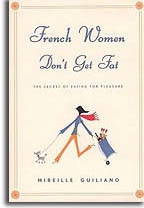 Here are Guiliano’s major points: (1) Consume food and Champagne, judiciously (she, of course, is promoting Champagne but you can easily plug in red wine), (2) Eat three meals a day with no snacking, (3) Consume smaller portions, (4) Eat lots of fruits and vegetables, (5) Drink plenty of water, (6) Do not deprive one’s self of special treats occasionally. It is all really very simple. Peter Mayle, wrote in Toujours Provence (a sequel to A Year in Provence), of his endless consumption of wine and pastis said, “It is impossible to live in France for any length of time and stay immune from the national enthusiasm for food, and who would want to? Why not make a daily pleasure out of a daily necessity? We have slipped into the gastronomic rhythm of Provence, taking advantage of the special offers provided by nature all through the year. Meat every day is a habit of the past. There is so much else: fish, fresh pasta, limitless recipes for vegetables, breads, hundreds of cheeses. It may be the change in our diet and the way it is cooked, always in olive oil, but we have both lost weight.”
The American ParadoxA corollary to the “The French Paradox” is “The American Paradox.” We have spent billions to match and surpass the French in health success. But we have failed miserably as our focus is on intervention rather than prevention and we have a persistent theme in this country that alcohol consumption of any kind is a dreaded and unwelcome threat to our well being. Our latest health escapade is reducing trans-fat, all the while ignoring that fact that our health is in the glass. We continue to support efforts to isolate the healthy components of wine so that we can achieve the benefits without actually drinking. A group of British scientists wrote in the respected medical journal, Lancet, “If wine is ever found to contain a constituent protective against cardiovascular disease, then we consider it almost a sacrilege that this constituent be isolated. The medicine is already in a highly palatable form.” They got that right.
Think Big When Purchasing Pinot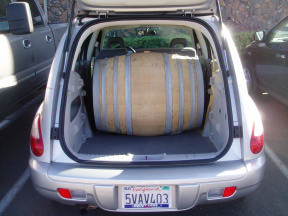 Forget buying great Pinot by the bottle or case. I have taken the next step - purchasing Pinot by the barrel. There are many advantages to this: no cork taint, no bottles or corks to throw out, less required bottle storage , practically endless stock of Pinot, no required corkscrew , and most important, better tasting wine from a barrel. Now you can scoff at your beer drinking friends with their puny kegs. My wife is not particularly enamored by my new idea. She insists that the oak barrel doesn’t fit in with our dining room furniture. I tried to explain to her that it was a Francois Freres barrel, practically brand new, and from France, but she frowned. I told her it was a great conversation piece, and after I outfitted it with a spigot, I could dispense Pinot to our friends and guests at a moments notice. No spilling of red wine on her nice tablecloths while pouring from a bottle either. We are still negotiating. |